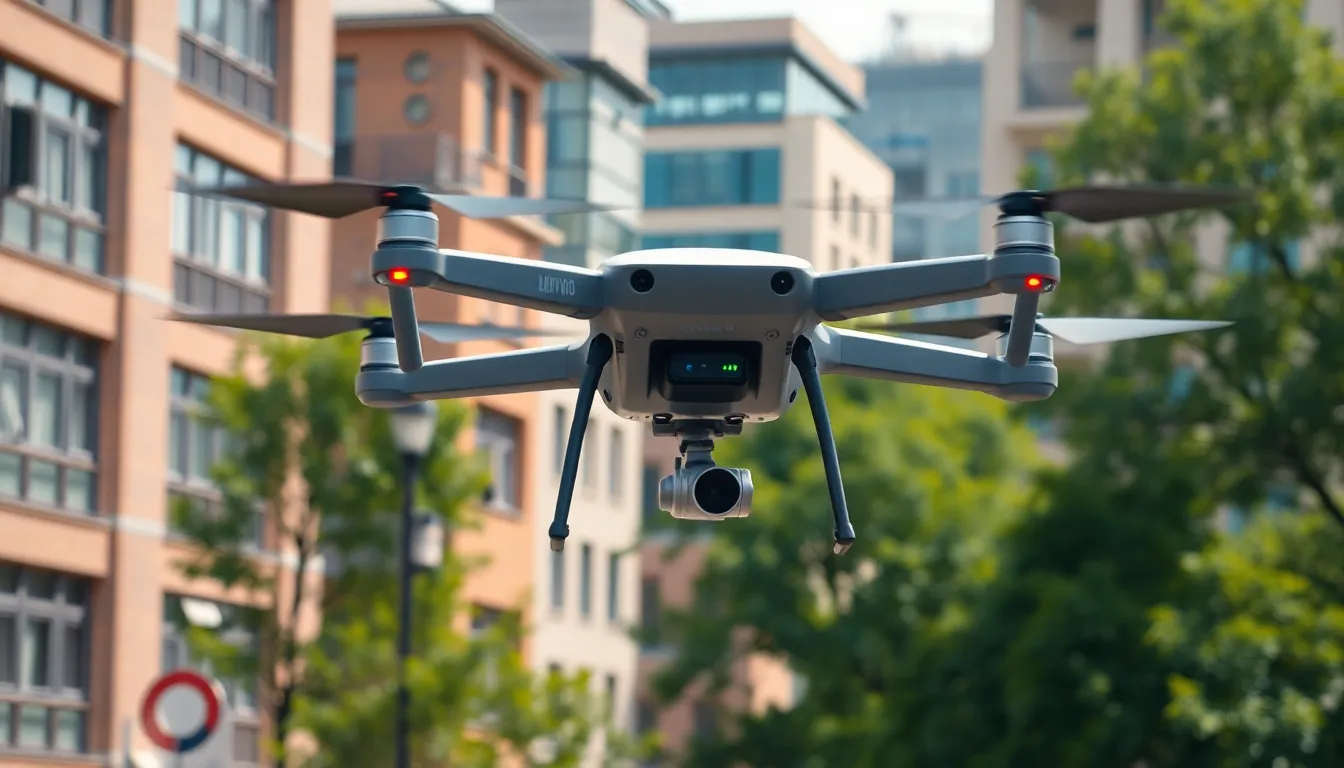In a world where drones are buzzing around like over-caffeinated bees, navigating through the air can feel like a game of aerial dodgeball. One wrong move and—oops!—it’s a crash landing. That’s where drone obstacle avoidance swoops in like a superhero, saving the day and those expensive gadgets from a premature demise.
Table of Contents
ToggleOverview of Drone Obstacle Avoidance
Drone obstacle avoidance focuses on preventing collisions during flight. This technology employs sensors and algorithms to detect obstacles in real-time. Various types of sensors, including cameras, ultrasonic sensors, and LIDAR, enhance obstacle detection capabilities. Detection ranges typically vary from a few centimeters to several hundred meters, depending on the sensor type.
Most drones equipped with obstacle avoidance systems analyze surrounding environments to predict potential collisions. These systems utilize artificial intelligence and machine learning to improve decision-making efficiency. When encountering an obstacle, drones can autonomously reroute, ascend, descend, or hover to avoid crashes.
Industry advancements have led to significant improvements in obstacle avoidance technologies. Recent models often feature 360-degree sensing, allowing drones to monitor their surroundings comprehensively. Many manufacturers apply software updates to enhance obstacle avoidance functions, ensuring drones operate at peak performance.
The implementation of obstacle avoidance technology benefits various applications. In commercial delivery services, it minimizes delays caused by crashes. In agricultural monitoring, it keeps drones focused on crops while steering clear of structures and livestock.
Safety regulations increasingly emphasize the need for effective obstacle avoidance in drone operations. Compliance with these regulations fosters trust among users and regulatory bodies. As drone technology continues to evolve, enhancing obstacle avoidance systems remains a priority for developers and operators alike.
Importance of Obstacle Avoidance in Drones

Obstacle avoidance technology is essential for safe and efficient drone operations. This capability significantly reduces the risk of crashes and protects both the drone and surrounding assets.
Safety Considerations
Safety remains a top priority for drone operators. Drones equipped with obstacle avoidance systems can detect objects in their flight path, allowing for timely adjustments. Collisions can lead to costly damages and liability issues. By utilizing sensors like LIDAR and cameras, drones enhance their awareness of the environment. Real-time data processing enables immediate responses to potential hazards. Compliance with safety regulations also fosters trust among users and regulators. Without these systems, flying in complex environments increases the likelihood of accidents. Therefore, implementing effective obstacle avoidance technology strengthens overall safety measures.
Operational Efficiency
Operational efficiency benefits greatly from advanced obstacle avoidance technology. Drones equipped with real-time detection systems can navigate more effectively, saving time during flights. These systems facilitate autonomous rerouting, which minimizes delays caused by manual intervention. The ability to fly safely around obstacles also allows for more versatile operations in urban areas. Time savings translate into increased productivity, especially in industries like logistics and agriculture. With consistent software updates, performance continues to improve, enhancing efficiency. Overall, efficient navigation through complex environments optimizes resource usage and operational capabilities.
Techniques for Drone Obstacle Avoidance
Drones use various techniques to navigate and avoid obstacles effectively. Understanding these methods ensures safer operations and enhances performance in complex environments.
Sensor-Based Approaches
Sensors form the backbone of drone obstacle avoidance systems. Cameras capture images for identifying obstacles visually. Ultrasonic sensors detect nearby objects using sound waves, operating well in short ranges. LIDAR systems provide precise distance measurements by employing laser pulses, enabling detection of obstacles from several meters away. These sensor types often work in unison, creating a comprehensive picture of the surrounding environment. With advancements, many new drones now feature 360-degree sensing capabilities, allowing for obstacle detection from all angles. Such technology significantly minimizes crash risks.
Computer Vision Techniques
Computer vision techniques enhance drones’ ability to interpret visual data. They analyze images captured by onboard cameras to identify obstacles and navigate accordingly. Algorithms process this visual information in real-time, enabling immediate decision-making. Techniques like object recognition and depth perception play crucial roles in accurately assessing distances and potential hazards. By distinguishing between various objects, drones can autonomously adjust flight paths. Implementing these techniques promotes safer operations, especially in urban settings where obstacles are abundant.
Machine Learning Applications
Machine learning applications optimize obstacle avoidance through continuous improvement. Algorithms learn from large datasets, enabling drones to recognize patterns in their environment. Training these algorithms involves feeding them various scenarios and obstacles, enhancing their ability to react to new challenges. Real-time data processing allows drones to make informed decisions, adjusting their routes based on real-world feedback. This learning capability leads to increased efficiency and safety in navigation. As machine learning technology evolves, its role in drone obstacle avoidance is likely to become increasingly significant.
Challenges in Implementing Obstacle Avoidance
Implementing effective obstacle avoidance technology in drones faces numerous challenges. These challenges arise from environmental factors and technical limitations.
Environmental Factors
Weather conditions significantly impact sensor performance. Adverse weather like heavy rain, fog, or snow can obscure obstacle detection, leading to potential navigation issues. Light changes can also affect camera sensors, making it harder for drones to identify obstacles accurately. Additionally, urban environments present unique challenges, such as tall buildings and unpredictable movements of pedestrians or vehicles. These variables complicate real-time decision-making, requiring drones to adapt quickly to ensure safe operations.
Technical Limitations
Technical constraints in drones often hinder obstacle avoidance capabilities. Sensor ranges vary, with some sensors only detecting obstacles within a few centimeters, potentially missing larger hazards at greater distances. Integration of multiple sensor types, while beneficial, can lead to data overload, complicating processing tasks. Latency issues may arise, causing delays in obstacle recognition and response actions. Furthermore, reliance on advanced algorithms requires robust computing power, which may not be feasible in all drone models. These factors underscore the need for ongoing advancements and testing in obstacle avoidance technology.
Future Trends in Drone Obstacle Avoidance
Emerging advancements in drone obstacle avoidance technology promise significant improvements in safety and efficiency. Precision in obstacle detection relies heavily on cutting-edge sensor development. Researchers are increasingly focused on integrating LiDAR and advanced cameras, providing drones with enhanced environmental awareness. Robust algorithms further process this data, allowing drones to make faster decisions. Significant improvements in artificial intelligence techniques contribute to more intelligent routing, which minimizes collision risks.
Integration with autonomous systems represents another promising avenue. Drones now utilize advanced obstacle avoidance systems that work seamlessly with autonomous navigation frameworks. This synergy enables flying in complex urban environments while maintaining safety. Utilizing real-time data, drones intelligently adjust their flight paths and speeds in relation to dynamic obstacles. Industries like delivery services benefit greatly, as drones can optimize routes and reduce transit times while adhering to safety standards.
The advancements in drone obstacle avoidance technology are transforming how drones operate in complex environments. By leveraging sophisticated sensors and algorithms, these systems enhance safety and efficiency, allowing drones to navigate crowded airspace with confidence. As developers continue to improve detection capabilities and real-time decision-making, the potential for drones to perform a wider range of tasks grows.
Future innovations promise to address current challenges, ensuring that drones can adapt seamlessly to various conditions. This evolution not only protects valuable equipment but also fosters trust within the industry. As drone technology progresses, the integration of advanced obstacle avoidance systems will be crucial for maximizing operational effectiveness across multiple sectors.









